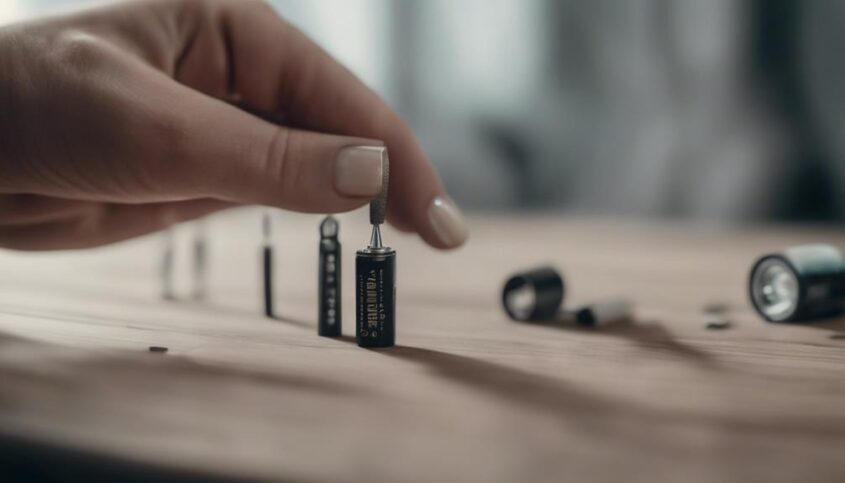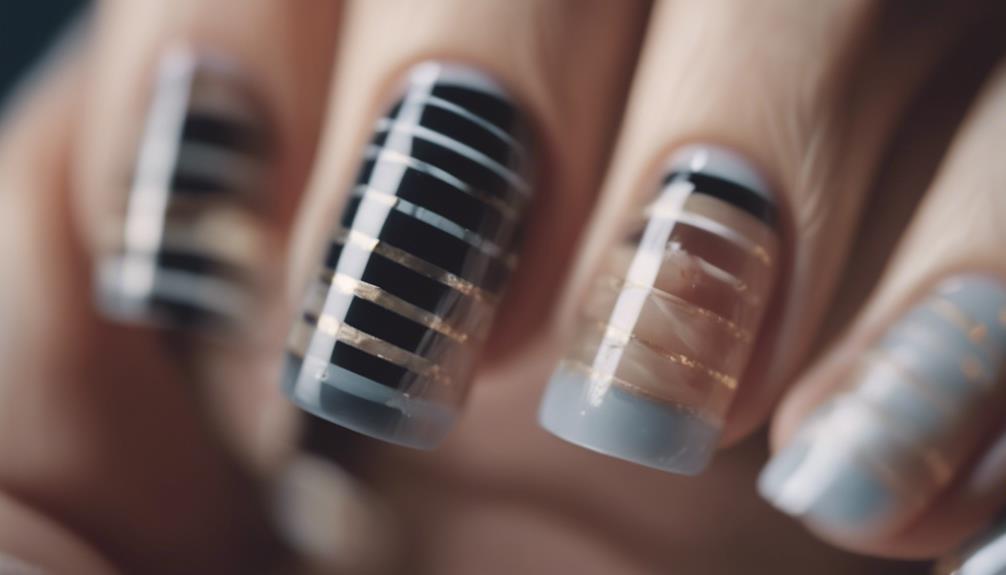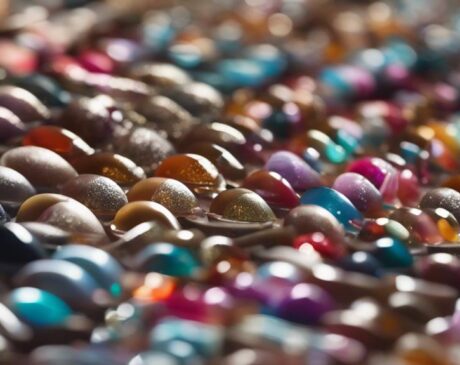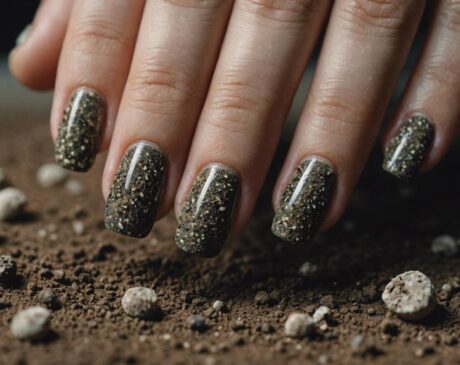Is Glue or Tape Better for Press on Nails?

For press-on nails, glue offers a strong and long-lasting hold, preserving natural nail health. However, it can be messy to apply and may weaken nails over time. Tape, on the other hand, provides easy application and removal with less adhesion and durability. Glue ensures a secure bond, while tape feels lightweight. Choose based on your priorities.
Key Takeaways
- Glue offers longer-lasting hold and stronger adhesion for a secure manicure.
- Tape provides mess-free application, easy removal, and convenience for temporary wear.
- Glue may damage natural nails over time due to harsh chemicals.
- Tape is quick to apply, but may have adhesion concerns for durability.
- The choice between glue and tape depends on desired longevity, convenience, and nail health concerns.
Pros of Using Glue for Press-on Nails

Glue is often favored for press-on nails due to its strong adhesive properties and long-lasting hold. When comparing application durability between tape and glue for press-on nails, glue emerges as the superior choice. The adhesive in glue provides a more secure bond, ensuring that the nails stay in place for an extended period, even with daily activities. This durability is essential for individuals seeking a long-term nail enhancement solution.
Moreover, in terms of nail health, glue tends to be gentler compared to tape. Glue creates a smooth surface that adheres directly to the natural nail, reducing the risk of damage during removal. On the other hand, tape can be harsh on nails, potentially causing splitting or weakening. By opting for glue, individuals can maintain the health and strength of their natural nails while enjoying the benefits of press-on nails.
Cons of Using Glue for Press-on Nails
Using glue for press-on nails comes with its drawbacks, including the potential for messy application, difficulty in achieving a precise placement, and the risk of damaging natural nails when removing the press-ons. Issues with nail glue can also include allergic reactions for some users or a strong chemical odor that may be unpleasant.
Glue Drawbacks for Nails
When adhering press-on nails, it is important to be aware of the potential drawbacks associated with the use of adhesive products. While nail glue provides strong adhesion, it can have drawbacks related to nail health.
Prolonged use of nail glue can weaken the natural nails, leading to brittleness and breakage. Additionally, some individuals may experience sensitivity or allergies to the ingredients in nail glue, causing irritation or adverse reactions on the skin surrounding the nails. It is crucial to monitor any negative effects and discontinue use if any discomfort or issues arise.
Understanding these drawbacks can help users make informed decisions when choosing between glue and other methods for applying press-on nails.
Issues With Nail Glue
Adhering press-on nails with adhesive products, particularly nail glue, poses several concerns that users should be mindful of to maintain optimal nail health and avoid potential drawbacks. While nail glue is a popular choice for its strong bond, it can have negative effects on nail health. One issue is adhesive sensitivity, where some individuals may experience allergic reactions or skin irritation from the chemicals in the glue.
Additionally, the removal process of nails attached with glue can sometimes lead to nail damage if not done properly. To mitigate these concerns, individuals may consider alternative methods for applying press-on nails that are gentler on the nails and skin, and ensure proper care is taken during both application and removal processes.
Glue Disadvantages for Nails
Nail glue presents significant drawbacks when used to attach press-on nails, impacting both nail health and user experience. One of the main disadvantages of using glue is the potential damage it can cause to natural nails when applying or removing press-on nails. The harsh chemicals in some nail glues can weaken the nails over time, leading to brittleness and breakage.
Additionally, glue may not provide the flexibility that tape does, making it more prone to popping off or causing discomfort. Considering these drawbacks, exploring glue alternatives such as double-sided nail tape can offer a more nail-friendly and user-friendly option. Tape benefits include easy application, gentle removal, and the ability to reposition nails without damaging the natural nail bed.
Pros of Using Tape for Press-on Nails
Using tape as an alternative adhesive for press-on nails offers a convenient and mess-free application method. Tape provides a durable hold for the nails, ensuring that they stay in place for an extended period. Unlike glue, which can be messy and challenging to apply evenly, tape offers a cleaner and more precise application process.
Tape's durability is a significant advantage, as it can withstand daily activities without the risk of the nails popping off unexpectedly. This reliability is especially beneficial for individuals with active lifestyles who need their press-on nails to stay put throughout the day. Additionally, tape eliminates the need for waiting for glue to dry, allowing for a quicker application process.
Furthermore, tape is easy to remove without causing damage to the natural nails, making it a practical choice for those who like to frequently change their nail designs. Overall, the use of tape for press-on nails presents a modern and efficient alternative to traditional glue adhesives.
Cons of Using Tape for Press-on Nails

While tape offers several benefits for adhering press-on nails, there are also drawbacks to consider when opting for this adhesive method. One of the primary limitations of using tape for press-on nails is its adhesion concerns. Tape may not provide as strong or long-lasting of a hold compared to glue. Factors such as moisture, oils from the skin, or daily activities like washing hands frequently can weaken the tape's adhesive properties, leading to the press-on nails becoming loose or falling off sooner.
Additionally, tape may not work as effectively on certain nail shapes or sizes. Press-on nails with larger surface areas or those that extend past the natural nail bed may not adhere well with tape alone, increasing the risk of them lifting or popping off unexpectedly. While tape can be a convenient option for quick nail applications, its limitations in terms of adhesion and longevity make it less reliable for those seeking a more durable and secure nail attachment method.
Longevity: Glue Vs. Tape
Considering the need for durability and lasting wear of press-on nails, the comparison between glue and tape in terms of longevity is a significant factor to explore. When it comes to longevity, glue tends to outperform tape due to its superior adhesive strength. Glue provides a more secure bond, ensuring that press-on nails stay in place for an extended period. This enhanced adhesion translates into a longer-lasting manicure, which is particularly appealing for individuals seeking a low-maintenance nail solution.
In contrast, tape may not offer the same level of longevity as glue. While tape can be convenient for temporary wear or quick fixes, it may not hold up as well over time. Additionally, the removal ease of tape can sometimes result in press-on nails detaching sooner than desired, impacting the overall longevity of the manicure.
Moreover, considering nail health, the prolonged wear provided by glue can be beneficial as it minimizes the need for frequent removal and reapplication, reducing potential damage to the natural nails. Ultimately, for those prioritizing longevity and durability, glue appears to be the preferred choice for press-on nails.
Application Process: Glue Vs. Tape

The application process of press-on nails differs between glue and tape in terms of ease and precision. When it comes to application speed, using glue generally requires more time and precision compared to tape. Glue application demands careful placement to ensure proper adhesion, which can be time-consuming for some users. On the other hand, tape offers a quicker and more straightforward application process. Simply peeling off the backing and pressing the nail onto the natural nail allows for a fast and convenient application, making it a preferred choice for those looking for efficiency.
In terms of precision, glue provides a more secure and precise application. The ability to control the amount of glue applied allows for a customized fit and better adherence to the natural nail. This precision results in a more durable hold compared to tape, which may not offer the same level of security. However, tape excels in ease of application, making it a suitable option for those seeking a quick and hassle-free nail enhancement solution.
Removal Process: Glue Vs. Tape
When removing press-on nails applied with glue, one might encounter the challenge of residue removal, requiring additional steps for thorough cleansing.
Conversely, nails secured with tape offer the benefit of easy peeling, resulting in a simpler removal process overall.
Understanding these differences can help individuals choose the most suitable method based on their preferences and convenience.
Glue Residue Removal
In the process of removing glue residue from press-on nails, the effectiveness of both glue and tape varies significantly. Residue removal techniques play a vital role in maintaining nail care and health.
When dealing with adhesive sensitivity and aiming to protect nail health, the method of removing glue residue becomes crucial. Glue residue removal may require more effort and precision compared to tape. It is essential to choose a method that not only effectively removes the residue but also minimizes damage to the natural nail.
Proper techniques for removing glue residue can help prevent potential nail damage and ensure that the nail bed remains healthy and strong for future applications.
Tape Easy Peel
When comparing the removal process of tape to that of glue for press-on nails, the ease of peel-off with tape presents a convenient alternative to the potentially more intricate glue residue removal method.
Tape offers an easy application process, allowing for quick and hassle-free removal without the need for soaking or using harsh chemicals. The strong hold provided by the tape ensures that the press-on nails stay securely in place during wear but can be effortlessly peeled off when desired.
This innovative approach to press-on nail removal simplifies the maintenance process, offering a user-friendly solution for those looking for a convenient and efficient way to switch up their nail looks without the hassle of dealing with sticky residues.
Overall Convenience and Comfort

For those seeking a balance between ease of application and comfortable wear, the choice between glue and tape for press-on nails is crucial. When considering overall convenience and comfort, both glue and tape have their unique benefits. Glue tends to provide a more secure hold, ensuring long-lasting wear, while tape offers quick application and easy removal without the mess.
To help you decide which option aligns best with your preferences, let's compare the two in terms of comfort level and application time:
| Criteria | Glue | Tape |
|---|---|---|
| Comfort Level | Provides a strong, secure bond that | Offers a lightweight feel on the |
| can feel slightly heavier on the | nails, ideal for those who prefer a | |
| nails but ensures durability. | more natural sensation. | |
| Application Time | Requires precision during application | Quick and easy to apply, making it |
| to avoid excess glue. | a convenient choice for on-the-go. |
Ultimately, the decision between glue and tape for press-on nails depends on your priorities – whether you value longevity or quick application and comfort.
Frequently Asked Questions
Can I Use Both Glue and Tape for Press-On Nails for Extra Hold?
For optimal durability and a secure hold, a combination application of glue and tape can be utilized for press-on nails. To maintain longevity, establish a proper maintenance routine. When removing, gently soak nails in warm water to loosen adhesive.
Are There Any Specific Types of Glue or Tape That Are Recommended for Press-On Nails?
When seeking optimal adhesion for press-on nails, consider exploring tape alternatives specifically designed for nail applications. Additionally, employing precise glue application techniques, such as using a thin layer and allowing proper drying time, can enhance longevity and durability.
How Often Should I Replace the Glue or Tape When Reapplying Press-On Nails?
When maintaining the longevity and adhesive effectiveness of press-on nails, it is recommended to replace the glue or tape with each reapplication. This practice ensures optimal performance and a fresh bond for innovative nail enhancements.
Can I Swim or Shower With Press-On Nails Applied With Glue or Tape?
When considering nail care and the durability of press-on nails, it's important to address whether they are waterproof. Confirm if swimming or showering is advisable with press-on nails attached using glue or tape for long-lasting results.
Are There Any Tips for Preventing Damage to My Natural Nails When Using Glue or Tape for Press-On Nails?
To maintain healthy natural nails when using glue or tape for press-on nails, prioritize nail care by keeping them clean, trimmed, and moisturized. During the removal process, gently soak nails in acetone to dissolve adhesive without causing damage.
Conclusion
In conclusion, when comparing glue and tape for press-on nails, both have their own advantages and disadvantages. Glue offers a stronger bond and longer wear time, but can be messy to apply and remove.
Tape, on the other hand, is easier to apply and remove, but may not hold as well or last as long.
Ultimately, the choice between glue and tape comes down to personal preference and desired convenience.




